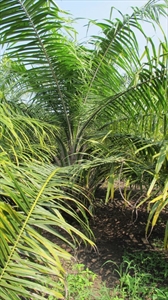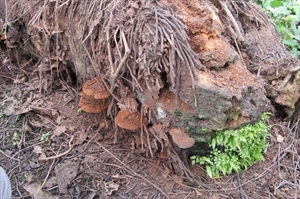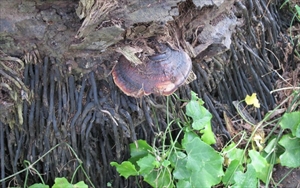Basal stem rot of oil palm
Pacific Pests, Pathogens, Weeds & Pesticides - Online edition
Pacific Pests, Pathogens, Weeds & Pesticides
Oil palm basal stem rot (275)
Ganoderma boninense
Asia, Africa, South (restricted) and Central America (restricted), Oceania. On oil palms, Ganoderma boninense is recorded from Papua New Guinea and Solomon Islands. It has also been recorded from Australia and Samoa on other hosts.
Wide; Albizia, betel nut, Casuarina, coconut, Livistona, oil palm, and other palms. However, it is difficult to be sure of the hosts of Ganoderma boninense because different Ganoderma species look similar, and it is difficult to test that they cause disease. For instance, even though Ganoderma boninense is known to attack oil palms, the only reliable way to identify specimens is by molecular methods, and the only way to test pathogenicity of specimens is to place a large infected block of rubber wood beneath a seedling, and wait several months.
In young palms, the lower leaves become yellow or develop yellow/green irregular spots and patches, called a mottle; they bend downwards, and then begin to rot prematurely (Photo 1). The unfolded leaves become yellow, shorter than normal, and sometimes develop rots at the tips. Later, growth slows, palms become pale and spear leaves remain unopened (Photo 2). Symptoms on mature palms are similar: they also show multiple unopened spear leaves, and pale leaves. Internally, dry rots occur in the stem and bole, and dry, powdery rots occur in the roots. Young palms die within 6-12 month of first symptoms, whereas mature palms may survive for 2-3 years, or longer.
The spore-producing structures or 'brackets', technically called 'basidiocarps' continue to form along the trunk, whether the palm remains in place, falls or is felled (Photos 3). They are up to 6 cm, or greater, brown on the top, and white below (Photos 4-6).
In South Asia, but not in Indonesia or Malaysia, coconut is also said to be affected by Ganoderma boninense. Leaves wilt, nuts become small, and lower leaves rot. Eventually, a basal rot develops in the trunk, roots decay, and brackets develop.
The life-cycle of Ganoderma boninense is not well known. For instance, how do palms become infected? Is it from root-to-root contact, or from spores produced in the brackets? There is evidence for both.
Support for root infections as the cause of basal stem rot comes from (i) artificial inoculations of seedlings, (ii) seedlings planted near Ganoderma-infected trunks in the field become infected the closer they are to the trunks, and (iii) the same is true for seedlings planted near Ganoderma-infected stumps from previous plantings. In these situations, roots become infected when they contact infected soil debris or infected roots. But maps of diseased palms show little evidence that the disease forms expanding clusters growing out from a common source, which might be expected if root-to-root infection was the main method of infection.
Evidence that spores are the source of infection comes from molecular studies; these show that the fungus is genetically variable within oil palm plantations in Indonesia, Malaysia and Papua New Guinea, i.e. they contain many different strains of Ganoderma, but that infections in neighbouring oil palms are not the same. In some cases, several different strains of the fungus occur in a single palm.
In these situations, the most likely answer is that spores are the source of infections, each spore being genetically different.
At present, however, the role of spores in the development of basal stem rots remains unclear. Spores are common in plantations, and so too are wounds made during routine harvesting - leaf bases are trimmed to release the fruit, and bunches are removed by cutting the fruit stalk - so it is possible spores infect oil palms at these times.
Coconuts may also be a source of infection for oil palm after the coconuts have been cut down. There is also evidence that coconuts may be infected by Ganoderma boninense while alive but without showing symptoms until they die naturally and produce brackets.
Basal stem rot is a serious problem in oil palms in Indonesia and Malaysia and more recently in Papua New Guinea and Solomon Islands. Once infected, there is no cure. In these countries, basal stem rot is the most important disease. It is a slow progressing infection, but one which is increasing in incidence.
When basal stem rot was first recognised in Malaysia in the 1920s it was mostly found in 30-year-old palms towards the end of their commercial life. By the 1950s, however, it was being seen in 10-15-year-old palms. In the last decade, surveys have shown an average incidences of 30% in coastal areas, with palms as young as 2-years-old showing symptoms.
The situation is similar in Indonesia. For instance, in North Sumatra, 40-50% of palms are lost at the time of replanting (25 years), with the majority of standing palms showing disease symptoms. The situation is similar in Solomon Islands where, as in other countries, incidence of basal stem rot has been steadily rising with each new replanting.
Oil palms with basal stem rot levels of up to 20% are still economically viable, but with levels above that plantations become uneconomic.
Look for yellowing/mottling of the leaves, spear leaves that do not unfold - symptoms associated with slowing growth. Look for Ganoderma brackets at the base of the palms or growing from the roots. Inspect oil palm plantations regularly, every 3 months is recommended.
CULTURAL CONTROL
Before planting:
- Stump removal is recommended throughout Southeast Asia on the assumption that spread of basal stem rot occurs by root-to-root contact, rather than spores. Whether or not to use the method depends on how much Ganoderma boninense infection occurred in the previous crop, and the costs of removing stumps, as it is labour intensive.
- Clean-clearing: remove the bole and root mass of individual oil palms by digging a 1.5 square by 60 cm pit at the planting points. Shred the debris and plant a legume cover crop over the area to hasten decay of the debris.
- Windrowing: place felled oil palm trunks, roots and leaves in the rows of the old palms. Leave them unshredded, but hasten decay by cutting the trunks into sections. Note, the windrow material may be breeding sites for Oryctes rhinoceros beetles.
- Ploughing: Plough to a depth of 60 cm, and then harrow in order to reduce the size of roots in areas where basal root rot is common. Do this twice.
- Cover crops: It has become standard practice to plant legume cover crops in plantations before planting or replanting. Cover crops are essential, not only to hasten decay of trunks infected with Ganoderma, but because of nutrient recycling, nitrogen fixation and weed control.
During growth:
- Mounding: heap soil around the base of diseased palms so that new roots are produced and the trees are given support. Do this on all infected trees over 15 years old.
- Trenching: a method applied in the past, but not now recommended: it is labour intensive, and experience shows that trenches are not maintained. Also, it is probably not effective, especially as there is circumstantial evidence that root-to-root spread is not the main way that the fungus spreads.
RESISTANT VARIETIES
Differences in resistance between the "dura" and "tenera" varieties exist, and plant breeders are using this to develop palms tolerant to basal stem rot.
CHEMICAL CONTROL
There are no chemicals that can be recommended for commercial or smallholder plantations that would cure the trees once they are infected.
AUTHOR Grahame Jackson
Information from Rees RW, et al. (2012) Ganoderna boninense basidiospores in oil palm plantations: evaluation of their possible role in stem rots of Elaeis guineensis. Plant Pathology 61:567-578; and Chung Gait Fee (2011) Management of Ganoderma diseases in oil palm plantations. Sustainable agriculture - an insight into Ganoderma. Agrinos Sdn. Bhd., Kuala Lumpur; and CABI (2012) Ganoderma boninense (basal stem rot of oil palm). Crop Protection Compendium. (https://www.cabi.org/cpc/datasheet/24924); and from Hushiarian R, et al. (2013) Detection and control of Ganoderma boninense: strategies and perspectives. PMC. (doi: 10.1186/2193-1801-2-555).
Produced with support from the Australian Centre for International Agricultural Research under project PC/2010/090: Strengthening integrated crop management research in the Pacific Islands in support of sustainable intensification of high-value crop production, implemented by the University of Queensland and the Secretariat of the Pacific Community.









